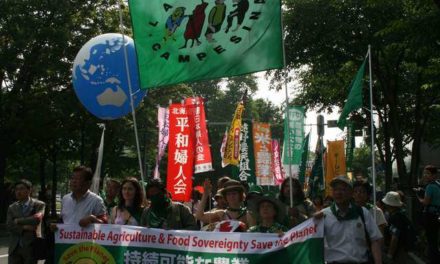By Walden Bello*
In contrast to their cautiously optimistic forecasts about a sustained recovery at the end of 2009, the dominant mood in liberal economic circles as 2010 draws to a close is gloom, if not doom. Fiscal hawks have gained the upper hand in the policy struggle in the United States and Europe, to the alarm of spending advocates like Nobel laureate Paul Krugman and Financial Times columnist Martin Wolf who see budgetary tightening as a surefire prescription for killing the hesitant recovery in the center economies.
But even as the U.S. and Europe appear to be headed for deeper crisis in the short term and stagnation in the long term, some analysts profess to discern a “decoupling” of East Asia and other developing areas from the western economies. This trend began in early 2009 on the strength of the massive Chinese stimulus program, which not only restored China to double-digit growth but swung several neighboring economies from Singapore to South Korea from recession to recovery. By 2010, Asia’s industrial production had caught up with its historical trend, “almost as if the Great Recession never happened,” as the Economist put it.
Are the U.S., Europe, and Asia really going their separate ways? Is “decoupling” really taking place?
The Triumph of Austerity
In the center economies, outrage with the excesses of the financial institutions that precipitated the economic crisis has given way to concern about the massive deficits that governments incurred to stabilize the financial system, arrest the collapse of the real economy, and stave off unemployment. In the United States, the deficit stands at over nine per cent of gross domestic product. This is hardly a runaway deficit, but the American right managed the feat of making the fear of the deficit and federal debt a greater force in the mind of the public than the fear of deepening stagnation and rising unemployment. In Britain and the United States, fiscal conservatives gained a clear electoral mandate in 2010 while in continental Europe, a more assertive Germany put the rest of the Eurozone on notice that it would no longer subsidize the deficits of the monetary union’s weaker Southern-tier economies such as Greece, Ireland, Spain, and Portugal.
In the U.S., the logic of reason gave way to the logic of ideology. The Democrats’ impeccable rationale that stimulus spending was necessary to save and create jobs was no match for the Republicans’ heated message that more stimulus spending added to President Obama’s $787 billion 2009 package would be one more step towards “socialism” and the “loss of individual freedom. “ In Europe, Keynesians argued that fiscal loosening would not only help the troubled economies of Southern Europe and Ireland but also the powerful German economic machine itself since these economies absorbed German exports. As in the U.S., solid rationale proved no match for provocative image, in this case, the media-disseminated portrayal of thrifty Germans subsidizing hedonistic Mediterraneans and spendthrift Irishmen. Germany has grudgingly approved bailout packages for Greece and Ireland, but only on condition that the Greeks and Irish are subjected to savage austerity programs that have been described by no less than two former high-ranking German ministers writing in the Financial Times as having a degree of social pain “unheard of in modern history.”
Decoupling Revived
The triumph of austerity in the U.S. and Europe will surely eliminate these two areas as engines of recovery for the global economy. But is Asia indeed on a different track, one that would make it bear, like Sisyphus, the burden of global growth?
The idea that Asia’s economic future had been decoupled from that of the center economies is not new. It was fashionable before the financial crisis dragged down the American economy in 2007-2008. But it was shown to be a mirage as the recession in the US, on which China and the other East Asian economies were dependent to absorb their exports, triggered a sudden and sharp downturn in Asia from late 2008 to mid-2009. This was the period that produced television images of millions of Chinese migrant workers being laid off in coastal economic zones and heading back to the countryside.
To counter the contraction, China, in panic, launched what Charles Dumas , author of Globalization Fractures, characterized as a “violent domestic stimulus” of 4 trillion yuan ($580 blllion). This came to about 13 per cent of gross domestic product in 2008 and constituted “probably the largest such program in history, even including wars.” The stimulus not only pulled China back to double-digit growth; it also pushed the East Asian economies that had become dependent on it to a steep recovery even as Europe and the US stagnated. It was this remarkable reversal that led to the renaissance of the decoupling idea.
The ruling Communist Party of China has reinforced this notion by claiming that a fundamental policy shift to prioritizing domestic consumption over export-led growth has taken place. But upon closer examination, this contention appears to be more rhetorical than real. In fact, export-led growth remains the strategic thrust, a fact that is underlined by China’s continuing refusal to let the yuan appreciate, a policy that is geared to keeping its exports competitive. The push-domestic-consumption phase appears to have ended, with China, as Dumas notes, “in the process of shifting massively from the beneficial stimulation of domestic demand to something closely resembling business as usual, circa 2005-07: export-led growth with a bit of overheating.”
It is not only Western analysts like Dumas that have pointed to this return to export-led growth. Yu Yongding, an influential technocrat that has served as a member of the monetary committee of China’s central bank, confirms that it is indeed back to business as usual: “With China’s trade-to-GDP ratio and exports-to-GDP ratio already respectively exceeding 60 percent and 30 percent, the economy cannot continue to depend on external demand to sustain growth. Unfortunately, with a large export sector that employs scores of millions of workers, this dependence has become structural. That means reducing China’s trade dependency and trade surplus is much more than a matter of adjusting macroeconomic policy.”
The retreat back to export-led growth is not merely a case of structural dependency. It is a case of a set of interests from the reform period that, as Yu puts it, “have morphed into vested interests, which are fighting hard to protect what they have.” The export lobby, which brings together private entrepreneurs, state enterprise managers, foreign investors, and government technocrats, is the strongest lobby in Beijing. If the justification for stimulus spending has been trumped by ideology in the US, in China the equally impeccable rationale for domestic-market-entered growth has been trounced by material interests.
Global Deflation
What analysts like Dumas refer to as China’s “reversion to type” as an export-oriented economy will clash with the efforts of the U.S. and Europe to push recovery through export-led growth while raising barriers to the inflow of Asian imports. The likely result of the competitive promotion of this volatile mix of export push and domestic protection by all three leading sectors of the global economy at a time of relatively less buoyant world trade will not be global expansion but global deflation. As Jeffrey Garten, former US undersecretary of commerce under Bill Clinton, has written: “While so much attention has focused on consumer and industrial demand in the US and China, the deflationary policies enveloping the EU, the world’s largest economic unit, could badly undermine global economic growth…The difficulties could cause Europe to redouble its focus on exports at the same time that the U.S., Asia, and Latin America are also betting their economies on selling more abroad, thereby exacerbating already-high currency tensions. It could lead to a resurgence of state-sponsored industrial policies, already growing around the world. And together, these factors could ignite the virulent protectionism that everyone fears.”
Crisis of the Old Order
What is in store for us in 2011 and beyond, Garten warns, is “exceptional turbulence as the waning days of the global economic order we have known plays out chaotically, possibly destructively.” He projects a pessimism that is increasingly capturing sections of the global elite that once heralded globalization but now see it disintegrating before their eyes. This resigned fin de siècle mood is not a western monopoly; it is shared by the influential Chinese technocrat Yu Yongding, who claims that China’s “growth pattern has now almost exhausted its potential.” The economy that most successfully rode the globalization wave, China “has reached a crucial juncture: without painful structural adjustments, the momentum of its economic growth could suddenly be lost. China’s rapid growth has been achieved at an extremely high cost. Only future generations will know the true price.”
Progressives in the Conjuncture
In contrast to the apprehensiveness of establishment figures like Garten and Yu, many progressives see turbulence and conflict as necessary accompaniments of the birth of a new order. Workers have indeed been on the move in China, where significant wage gains were won in strikes in selected foreign companies in 2010. Protesters are indeed out in Ireland, Greece, France, and Britain. Unlike in China, however, they are marching to preserve what rights they have left. And neither in China nor the West nor elsewhere are most of those resisting carrying an alternative vision to the global capitalist order. At least, not yet.
*A member of the House of Representatives of the Philippines, Walden Bello has written a number of books on global political economy, the latest of which is Food Wars (London: Verso, 2009). He is also as senior analyst at the Bangkok-based Focus on the Global South.








